Czichos H., Saito T., Smith L.E. (Eds.) Handbook of Metrology and Testing
Подождите немного. Документ загружается.

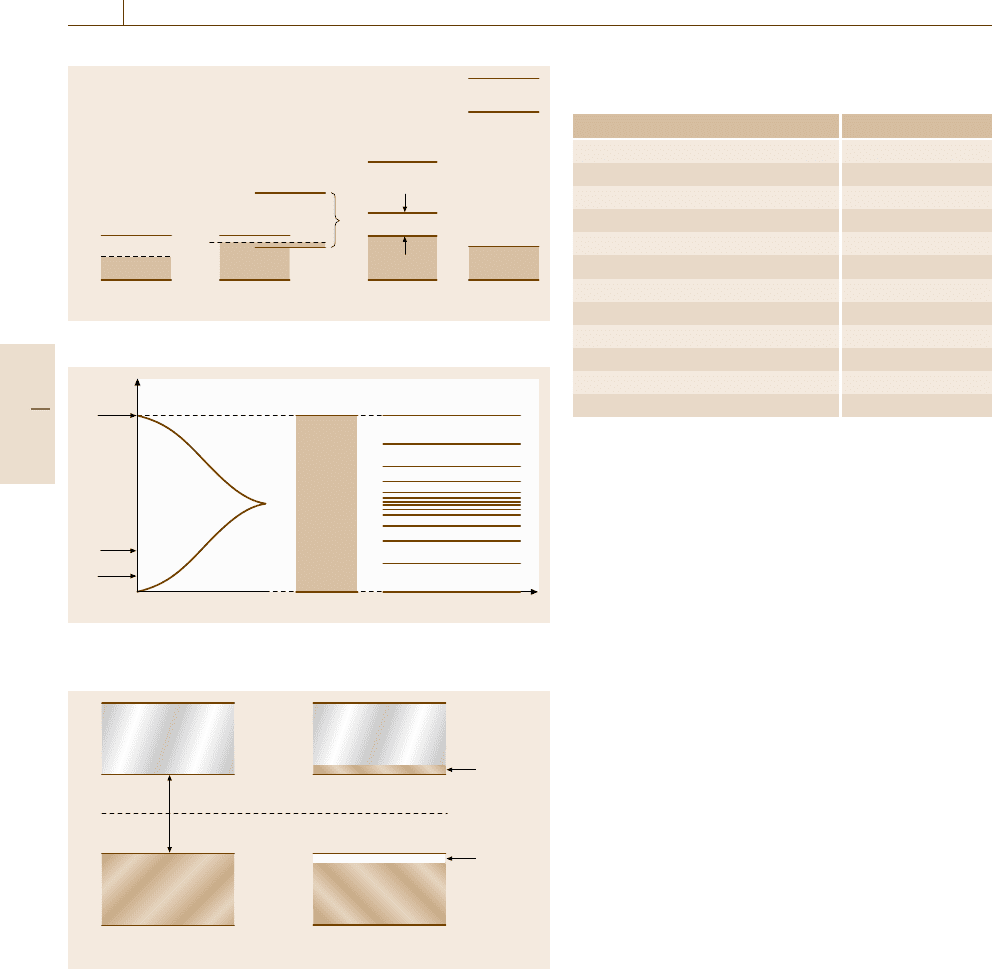
488 Part C Materials Properties Measurement
Monovalent metals Bivalent metals Semiconductors Insulators
3p
3s
E
F
E
F
Fig. 9.4 Electronic energy-band representation
Valence
band
Z (E)
E
E
i
E
m
E
b
Fig. 9.5 Schematic representation of the density of electrons within
an electron energy band
Conduction band
Electrons
(negative
charge
carriers)
Holes
(positive
charge
carriers)
Electrons
Valence band
300 K
0 K
E
g
E
F
Fig. 9.6 Simplified band diagrams for an intrinsic semiconductor
gen which is more readily available than other coolants.
Among the so-called high-T
c
superconductors are the
1-2-3 compounds such as YBa
2
Cu
3
O
7−x
, where mo-
lar ratios of rare earth to alkaline earth to copper relate
as 1 :2 :3. Their transition temperatures range from 40
to 134 K. Ceramic superconductors have an orthorhom-
bic, layered, perovskite crystal structure which contains
Table 9.1 Critical temperatures of some superconducting
materials (R =Gd, Dy, Ho, Er, Tm, Yb, Lu)
Materials T
c
(K)
Tungsten 0.01
Mercury 4.15
Sulfur-based organic superconductor 8
Nb
3
Sn and Nb-Ti 9
V
3
Si 17.1
Nb
3
Ge 23.2
La-Ba-Cu-O 40
YBa
2
Cu
3
O
7−x
≈92
RBa
2
Cu
3
O
7−x
≈92
Bi
2
Sr
2
Ca
2
Cu
3
O
10+δ
113
Tl
2
CaBa
2
Cu
2
O
10+δ
125
HgBa
2
Ca
2
Cu
3
O
8+δ
134
two-dimensional sheets and periodic oxygen vacancies.
(The superconductivity exists only parallel to these lay-
ers, that is, it is anisotropic.) The first superconducting
material was found by Kammerlingh Onnes in 1911 in
mercury which has a T
c
of 4.15 K. Methods to measure
superconductivity are described in Sect. 9.2.5.
9.1.3 Semiconductors
The electrical properties of semiconductors are com-
monly explained by making use of the electron band
structure model which is the result of quantum-
mechanical considerations. In simple terms, the elec-
trons are depicted to reside in certain allowed energy
regions.
Figure 9.6 depicts two electron bands, the lower of
which, at 0 K, is completely filled with valence elec-
trons. This band is appropriately called the valence
band. It is separated by a small gap (about 1.1eV for
Si) from the conduction band which contains no elec-
trons at 0 K. Further, quantum mechanics stipulates that
electrons essentially are not allowed to reside in the gap
between these bands (called the forbidden band). Since
the filled valence band possesses no allowed empty
energy states in which the electrons can be thermally
excited (and then accelerated in an electric field), and
since the conduction band contains no electrons at all,
silicon is an insulator at 0 K. The situation changes deci-
sively once the temperature is raised. In this case, some
electrons may be thermally excited across the band gap
and thus populate the conduction band (Fig. 9.6). The
number of these electrons is extremely small for statis-
tical reasons. Specifically, about one out of every 10
13
atoms contributes an electron at room temperature. Nev-
Part C 9.1
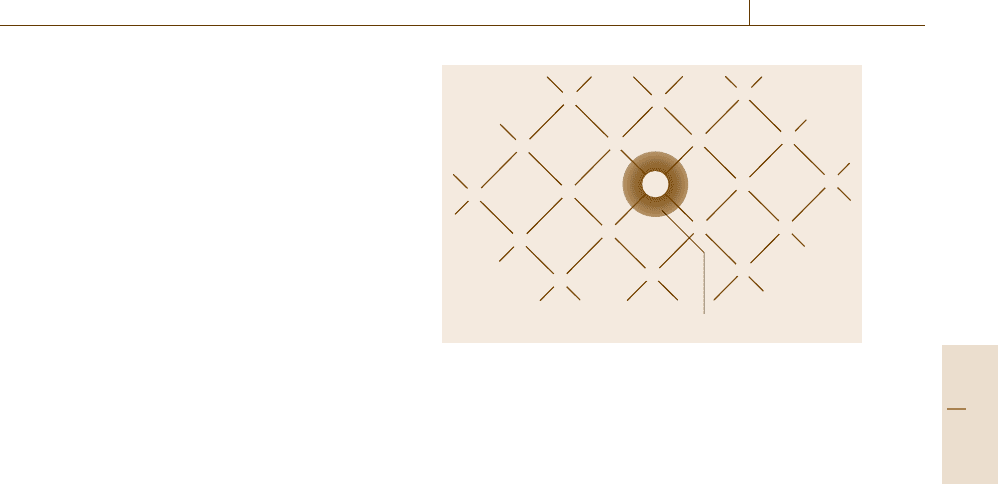
Electrical Properties 9.1 Electrical Materials 489
ertheless, this number is large enough to cause some
conduction. The number of electrons in the conduction
band N
e
increases exponentially with temperature T but
also depends, of course, on the size of the gap energy.
The conductivity depends naturally on the number of
these electrons but also on their mobility. The latter is
defined to be the velocity v per unit electric field E that
is μ = V/E. All taken, the conductivity is σ = N
e
μe,
where e is the charge of an electron. The mobility
of electrons is substantially impaired by interactions
with impurity atoms and other lattice imperfections (as
well as with vibrating lattice atoms). It is for this rea-
son that silicon has to be extremely pure and free of
grain boundaries which requires sophisticated and ex-
pensive manufacturing processes called zone refining or
Czochralski crucible pulling.
The conductivity for semiconductors increases with
rising temperature. This is in marked contrast to metals
and alloys, for which the conductivity decreases with
temperature. The thermal excitation of some electrons
across the band gap has another important conse-
quence. The electrons that have left the valence band
leave behind some empty spaces which allow addi-
tional conduction to take place in the valence band.
The empty spaces are called defect electrons or electron
holes. These holes may be considered to be positively
charged carriers similarly as electrons are defined to be
negatively charged carriers. In essence, at elevated tem-
peratures, the thermal energy causes some electrons to
be excited from the valence band into the conduction
band. They provide there some conduction. The elec-
tron holes which have been left behind in the valence
band cause a hole current which is directed in the op-
posite direction compared to the electron current. The
total conductivity, therefore, is a sum of both contribu-
tions σ = N
e
μ
e
e +N
h
μ
h
e, where the subscripts e and
h refer to electrons and holes, respectively. The process
is called intrinsic conduction and the material involved
is termed an intrinsic semiconductor since no foreign
elements are involved. The Fermi energy of intrinsic
semiconductors can be considered to be the average of
the electron and the hole Fermi energies and is therefore
situated near the center of the gap as depicted in Fig. 9.6.
The number of electrons in the conduction band
can be considerably increased by adding, for example,
to silicon small amounts of group-V elements called
donor atoms. Dopants such as phosphorous or arsenic
are commonly utilized which are added in amounts of,
for example, 0.0001%. These dopants replace some reg-
ular lattice atoms in a substitutional manner (Fig. 9.7).
Since phosphorous has five valence electrons, that is,
Negative charge cloud
Si
Si
Si
Si
Si
Si
Si
Si
Si
Si
Si
Si
Si
Si
Si
Si
Si
Si
P
+
Fig. 9.7 Two-dimensional representation of a silicon lat-
tice (covalent bonds) with a phosphorus atom substituting
a regular lattice atom
one more than silicon, the extra electron called the
donor electron is only loosely bound. The binding en-
ergy of phosphorous donor electrons in a silicon matrix
is about 0.045 eV. Thus, the donor electrons can be dis-
associated from their nuclei by only a slight increase in
thermal energy. At room temperature all donor electrons
have already been excited into the conduction band.
Near room temperature, only the majority carriers
need to be considered. For example, at room temper-
ature, all donor electrons in an n-type semiconductor
have been excited from the donor levels into the conduc-
tion band. At higher temperatures, however, intrinsic
effects may considerably contribute to the conduction.
Compounds made of group-III and group-V elements,
such as gallium arsenide, have similar semiconducting
properties as the group-IV materials silicon or germa-
nium. GaAs is of some technical interest because of
its above-mentioned wider band gap and because of its
larger electron mobility which aids in high-speed ap-
plications. Further, the ionization energies of donor and
acceptor impurities in GaAs are one order of magnitude
smaller than in silicon which ensures complete electron
(and hole) transfer from the donor (acceptor) levels into
the conduction (valence) bands even at relatively low
temperatures. However, GaAs is about ten times more
expensive than Si and its heat conduction is smaller.
Other compound semiconductors include II–VI combi-
nations such as ZnO, ZnS, ZnSe, or CdTe, and IV–VI
materials such as PbS, PbSe, or PbTe. Silicon carbide,
a IV–IV compound, has a band gap of 3 eV and can thus
be used up to 700
◦
C before intrinsic effects set in. The
most important application of compound semiconduc-
tors is, however, for optoelectronic purposes (e.g. for
light-emitting diodes and lasers).
Part C 9.1

490 Part C Materials Properties Measurement
9.1.4 Conduction in Polymers
Materials that are electrical (and thermal) insulators are
of great technical importance and are, therefore, used in
large quantities in the electronics industry. Most poly-
meric materials are insulating and have been used for
this purpose for decades. It came, therefore, as a sur-
prise when it was discovered that some polymers and
organic substances may have electrical properties which
resemble those of conventional semiconductors, met-
als, or even superconductors. Historically, transoidal
polyacetylene (Fig. 9.8) has been used as a conducting
polymer.
It represents what is called a conjugated organic
polymer, that is, it has alternating single and dou-
ble bonds between the carbon atoms. It is obtained
as a silvery, flexible, and lightweight film which
has a conductivity comparable to that of silicon.
Its conductivity increases with increasing temperature
similarly as in semiconductors. The conductivity of
trans-polyacetylene can be made to increase by up to
seven orders of magnitude by doping it with arsenic
pentafluoride, iodine, or bromine, which yields a p-type
semiconductor. Thus, σ approaches the lower end of the
conductivity of metals as shown in Fig. 9.9.
Among other dopants are n-dodecyl sulfonate
(soap). However, the stability of this material is very
poor; it deteriorates in hours or days. This very draw-
back which it shares with many other conducting
polymers nevertheless can be profitably utilized in spe-
cial devices such as remote gas sensors, biosensors, and
other remotely readable indicators which detect changes
in humidity, radiation dosage, mechanical abuse, or
chemical release. Other conducting polymers include
polypyrrole and polyaniline. The latter has a reasonably
good conductivity and a high environmental stability.
It has been used for electronic devices such as field-
effect transistors, electrochromic displays, as well as for
rechargeable batteries.
In order to better understand the electronic prop-
erties of polymers by means of the electron theory
HHHHHH
HHHHH
CCCCCC
CCCCC
Fig. 9.8 Transoidal isomer of polyacetylene
and the band structure concept, one needs to know
the degree of order or the degree of periodicity of the
atoms because only ordered and strongly interacting
atoms or molecules lead to distinct and wide electron
bands. It has been observed that the degree of order
in polymers depends on the regularity of the molecu-
lar structure. One of the electrons in the double bond
of a conjugated polymer can be considered to be only
loosely bound to the neighboring carbon atoms. Thus,
this electron can be easily disassociated from its car-
bon atom by a relatively small energy which may be
provided by thermal energy. The delocalized electrons
behave like free electrons and may be accelerated as
usual in an electric field. It should be noted in clos-
ing that the interpretation of conducting polymers is
still in flux and future research needs to clarify certain
points.
9.1.5 Ionic Conductors
Electrical conduction in ionically bonded materials,
such as the alkali-halides, is extremely small. The
reason for this is that the atoms in these chemical com-
Copper
Graphite:AsF
5
(SN)
x
Metals
Semi-
conductors
Insulators
Doped polypyrrole
(CH)
x
:AsF
5
Graphite
Doped polyazulene
Doped polyaniline
trans (CH)
x
cis (CH)
x
Nylon
Teflon
Polyester
1
Ω cm
σ
10
6
10
4
10
2
10
–2
10
–4
10
–6
10
–8
10
–10
10
–12
10
–14
10
–16
1
Fig. 9.9 Conductivity of various polymeric materials
Part C 9.1
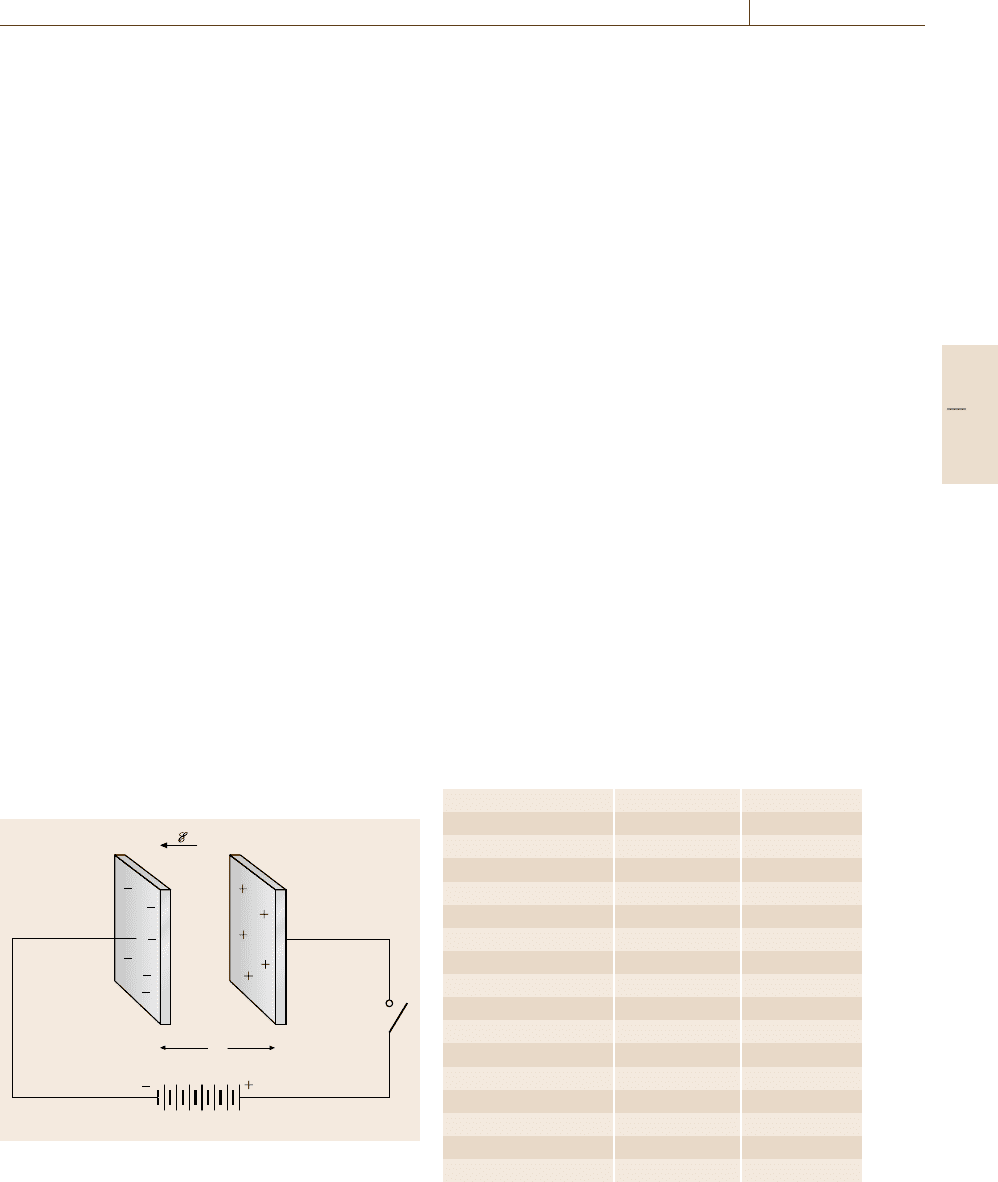
Electrical Properties 9.1 Electrical Materials 491
pounds strive to assume the noble gas configuration
for maximal stability and thus transfer electrons be-
tween each other to form positively charged cations
and negatively charged anions. The binding forces be-
tween the ions are electrostatic in nature, that is, they
are very strong. Essentially no free electrons are there-
fore formed. As a consequence, the room temperature
conductivity in ionic crystals is about 22 orders of mag-
nitude smaller than that of typical metallic conductors
(Fig. 9.2). The wide band gap in insulators allows only
extremely few electrons to become excited from the
valence into the conduction band (Fig. 9.4 right).
The main contribution to the electrical conduction in
ionic crystals (as little as it may be) is due to ionic con-
duction. Ionic conduction is caused by the movement of
some negatively (or positively) charged ions which hop
from lattice site to lattice site under the influence of an
electric field. The ionic conductivity σ
ion
= N
ion
eμ
ion
is the product of three quantities. In the present case,
N
ion
is the number of ions per unit volume which can
change their position under the influence of an electric
field whereas μ
ion
is the mobility of these ions. In or-
der for ions to move through a crystalline solid they
must have sufficient energy to pass over an energy bar-
rier. Further, an equivalent lattice site next to a given ion
must be empty in order for an ion to be able to change
its position. Thus, N
ion
depends on the vacancy concen-
tration in the crystal (i. e., on the number of Schottky
defects).
In short, the theory of ionic conduction contains es-
sential elements of diffusion theory. Diffusion theory
links the mobility of the ions with the diffusion coeffi-
cient D through the Einstein relation μ
ion
= De/(k
B
T).
A
V
L
Fig. 9.10 Principle of storing electric energy in a dielectric
capacitor
The diffusion coefficient varies with temperature by an
Arrhenius equation D = D
0
exp[−Q/(k
B
T)], where Q
is the activation energy for the process under considera-
tion and D
0
is a preexponential factor which depends
on the vibrational frequency of the atoms and some
structural parameters. Combining the equations yields
σ
ion
=[N
ion
e
2
D
0
/(k
B
T )]exp[Q/(k
B
T )]. This equation
is shortened by combining the preexponential constants
into σ
0
: σ
ion
=σ
0
exp[Q/(k
B
T )].
In summary, the ionic conduction increases ex-
ponentially with increasing temperature (as in semi-
conductors). Further, σ
ion
depends on a few other
parameters such as the number of ions that can change
their position, the vacancy concentration, as well as on
an activation energy.
9.1.6 Dielectricity
Dielectric materials, that is, insulators, possess a num-
ber of important electrical properties which make them
useful in the electronics industry.
When a voltage is momentarily applied to two par-
allel metal plates which are separated by a distance L as
showninFig.9.10, the resulting electric charge essen-
tially remains on these plates even after the voltage has
been removed (at least as long as the air is dry).
This ability to store an electric charge is called the
capacitance C whichisdefinedtobethechargeq per
applied voltage V that is C =q/V, where C is given in
coulombs per volt or farad. The capacitance is higher,
the larger the area A of the plates and the smaller the dis-
Table 9.2 DC dielectric constants of some materials
Barium titanate 4000 Ferroelectric
Water 81.1 Dielectric
Acetone 20
Silicon 11.8
GaAs 10.9
Marble 8.5
Soda-lime-glass 6.9
Porcelain 6.0
Epoxy 4.0
Fused silica 4.0
Nylon 6.6 4.0
PVC 3.5
Ice 3.0
Amber 2.8
Polyethylene 2.3
Paraffin 2.0
Air 1.000576
Part C 9.1

492 Part C Materials Properties Measurement
tance L between them. Further, the capacitance depends
on the material that may have been inserted between the
plates. The experimental observations lead to C = εε
0
(A/L), where ε = C/C
vac
determines the magnitude of
the added storage capability. It is called the (unitless)
dielectric constant (or occasionally the relative permit-
tivity ε
r
). ε
0
is a universal constant having the value of
8.85 × 10
−12
F/m (farad per meter) or A s/(V m) and is
known by the name permittivity of empty space (or of
vacuum).
Some values for the dielectric constant are given
in Table 9.2. The dielectric constant of empty space is
set to be 1 whereas ε of air and many other gases is
nearly 1.
The capacitance increases when a piece of a dielec-
tric material is inserted between two conductors. Under
the influence of an external electric field, the negatively
charged electron cloud of an atom becomes displaced
with respect to its positively charged core. As a result,
a dipole is created which has an electric dipole mo-
ment p = qx, where x is the separation between the
positive and the negative charge. (The dipole moment
is generally a vector pointing from the negative to the
positive charge.) The process of dipole formation (or
alignment of already existing dipoles) under the influ-
ence of an external electric field that has an electric field
strength E, is called polarization. Dipole formation of
all involved atoms within a dielectric material causes
a charge redistribution so that the surface which is near-
est to the positive capacitor plate is negatively charged.
As a consequence, electric field lines within a dielectric
are created which are opposite in direction to the exter-
nal field lines. Effectively, the electric field lines within
a dielectric material are weakened due to polarization.
The electric field strength E = V/L = E
vac
/ε is reduced
by inserting a dielectric between two capacitor plates.
Within a dielectric material the electric field strength E
is replaced by the dielectric displacement D (also called
the surface charge density), that is, D =εε
0
E = q/A.
The dielectric displacement is the superposition of two
terms: D = ε
0
E +P, where P is called the dielectric
polarization, that is, the induced electric dipole moment
per unit volume. The units for D and P are C/m
2
. The
polarization is responsible for the increase in charge
density (q/A) above that for vacuum.
The mechanism just described is known as elec-
tronic polarization. It occurs in all dielectric materials
that are subjected to an electric field. In ionic materials,
such as the alkali halides, an additional process may oc-
cur which is called ionic polarization. In short, cations
and anions are somewhat displaced from their equilib-
rium positions under the influence of an external field
and thus give rise to a net dipole moment. Finally, many
materials already possess permanent dipoles which can
be aligned in an external electric field. Among them
are water, oils, organic liquids, waxes, amorphous poly-
mers, polyvinylchloride, and certain ceramics such as
barium titanate (BaTiO
3
). This mechanism is termed
orientation polarization or molecular polarization. All
three polarization processes are additive if applicable.
Most capacitors are used in electric circuits in-
volving alternating currents. This requires the dipoles
to reorient quickly under a rapidly changing electric
field. Not all polarization mechanisms respond equally
quick to an alternating electric field. For example, many
molecules are relatively sluggish in reorientation. Thus,
molecular polarization breaks down already at relatively
low frequencies. In contrast, electronic polarization re-
sponds quite rapidly to an alternating electric field even
at frequencies up to 10
16
Hz. At certain frequencies
a substantial amount of the excitation energy is ab-
sorbed and transferred into heat. This process is called
dielectric loss. It is imperative to know the frequency for
dielectric losses for a given material so that the device
is not operated in this range.
9.1.7 Ferroelectricity and Piezoelectricity
Ferroelectricity is the electric analogue to ferromag-
netism (Chap. 10). Ferroelectric materials, such as
barium titanate, exhibit spontaneous polarization with-
out the presence of an external electric field. Their
dielectric constants are orders of magnitude larger than
those of dielectrics (Table 9.2). Thus, they are quite
suitable for the manufacturing of small-sized, highly
efficient capacitors. Most of all, however, ferroelectric
materials retain their state of polarization even after an
external electric field has been removed. Specifically, if
a ferroelectric is exposed to a strong electric field E,
its permanent dipoles become increasingly aligned with
the external field direction until eventually all dipoles
are parallel to E, and saturation of the polarization P
S
has been achieved as depicted in Fig. 9.11.
Once the external field has been withdrawn a rema-
nent polarization P
r
remains which can only be removed
by inverting the electric field until a coercive field E
c
has been reached. By further increasing the reverse
electric field, parallel orientation of the dipoles in the
opposite direction is achieved. Finally, when reversing
the field once more, a complete hysteresis loop is ob-
tained as depicted in Fig. 9.11. Therefore, ferroelectrics
can be utilized for memory devices in computers, etc.
Part C 9.1
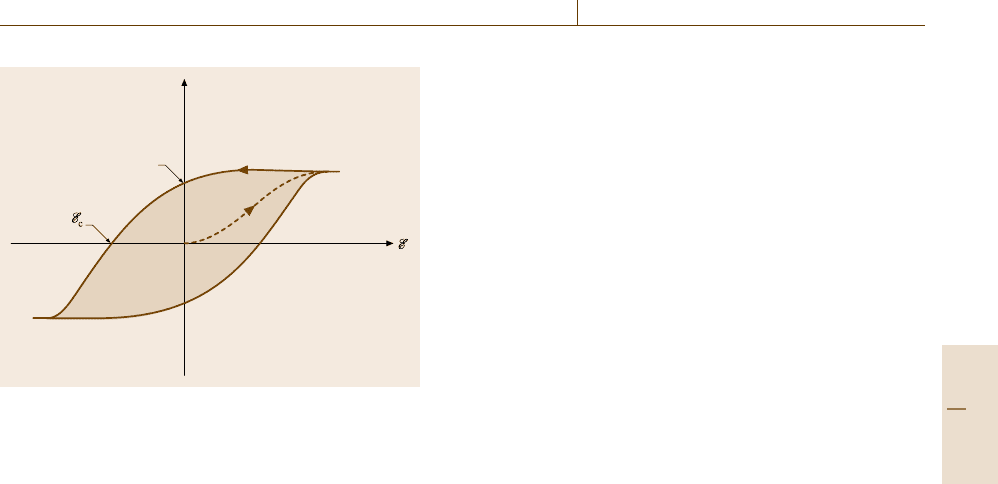
Electrical Properties 9.2 Electrical Conductivity of Metallic Materials 493
P
P
r
P
s
Fig. 9.11 Schematic representation of a hysteresis loop for
a ferroelectric material in an electric field
The area within a hysteresis loop is proportional to the
energy per unit volume that is dissipated once a full field
cycle has been completed.
A critical temperature, called the Curie tempera-
ture, exists above which the ferroelectric effects are
destroyed and the material becomes dielectric. Typical
Curie temperatures range from −200
◦
C for strontium
titanate to at least 640
◦
C for NaNbO
3
. By heat-
ing BaTiO
3
above its Curie temperature (120
◦
C), the
tetragonal unit cell transforms to a cubic cell whereby
the ions now assume symmetric positions. Thus, no
spontaneous alignment of dipoles remains and BaTiO
3
becomes dielectric.
If pressure is applied to a ferroelectric material
such as BaTiO
3
, a change in the polarization may oc-
cur which results in a small voltage across the sample.
Specifically, the slight change dimensions causes a vari-
ation in bond lengths between cations and anions. This
effect is called piezoelectricity. It is found in a number
of materials such as quartz (however, much weaker than
in BaTiO
3
), in ZnO, and in complicated ceramic com-
pounds such as PbZrTiO
6
. Piezoelectricity is utilized in
devices that are designed to convert mechanical strain
into electricity. Those devices are called transducers.
Applications include strain gages, microphones, sonar
detectors, and phonograph pickups, to mention a few.
The inverse mechanism, in which an electric field
produces a change in dimensions in a ferroelectric ma-
terial, is called electrostriction. An earphone utilizes
such a device. Probably the most important applica-
tion, however, is the quartz crystal resonator which is
used in electronic devices as a frequency selective ele-
ment. Specifically, a periodic strain is exerted to a quartz
crystal by an alternating electric field which excites
this crystal to vibrations. These vibrations are moni-
tored in turn by piezoelectricity. If the applied frequency
coincides with the natural resonance frequency of the
molecules, then amplification occurs. In this way, very
distinct frequencies are produced which are utilized for
clocks or radio frequency signals.
9.2 Electrical Conductivity of Metallic Materials
9.2.1 Scale of Electrical Conductivity;
Reference Materials
Precise measurements of the electrical conductivity date
back to the end of the 19th century. With the develop-
ment of the electrical industry it became important to
check the quality of the copper used in electrical ma-
chines. The Physikalisch-Technische Reichsanstalt in
Berlin, Germany, for instance, was strongly supported
by Werner von Siemens, head of the Siemens company.
Nowadays, copper is still an important part where con-
ductivity measurements are applied. Furthermore, the
aircraft manufacturing industry uses conductivity mea-
surements for the quality assurance of aluminum alloys.
Recently, it became also important for the coin man-
ufacturing industry. With the introduction of the Euro,
these coins are produced all over Europe, but have to
meet strong criteria in conductivity, on the one hand to
protect the consumers from fraud, on the other hand for
the acceptance of coins in vending machines.
Conductivity is usually measured in the unit MS/m,
or μΩ m. In practice, the values are commonly given
in so-called % IACS, which stands for Percent Inter-
national Annealed Copper Standard. This standard is
a hypothetical copper bar of 1 m in length and 1 mm
2
in
area having a resistance of 1/58 Ω.
Typical values for some metals and alloys are listed
in Table 9.3. Generally there are three main areas
for conductivity measurements, conductors (copper) at
100% IACS, aluminum alloys at 50% IACS and alloys
for coins at 10% IACS. Instruments for the measure-
ment of conductivity operate either with direct current
methods (DC) or alternating current methods (AC).
The DC methods usually is a voltage–current method,
Part C 9.2
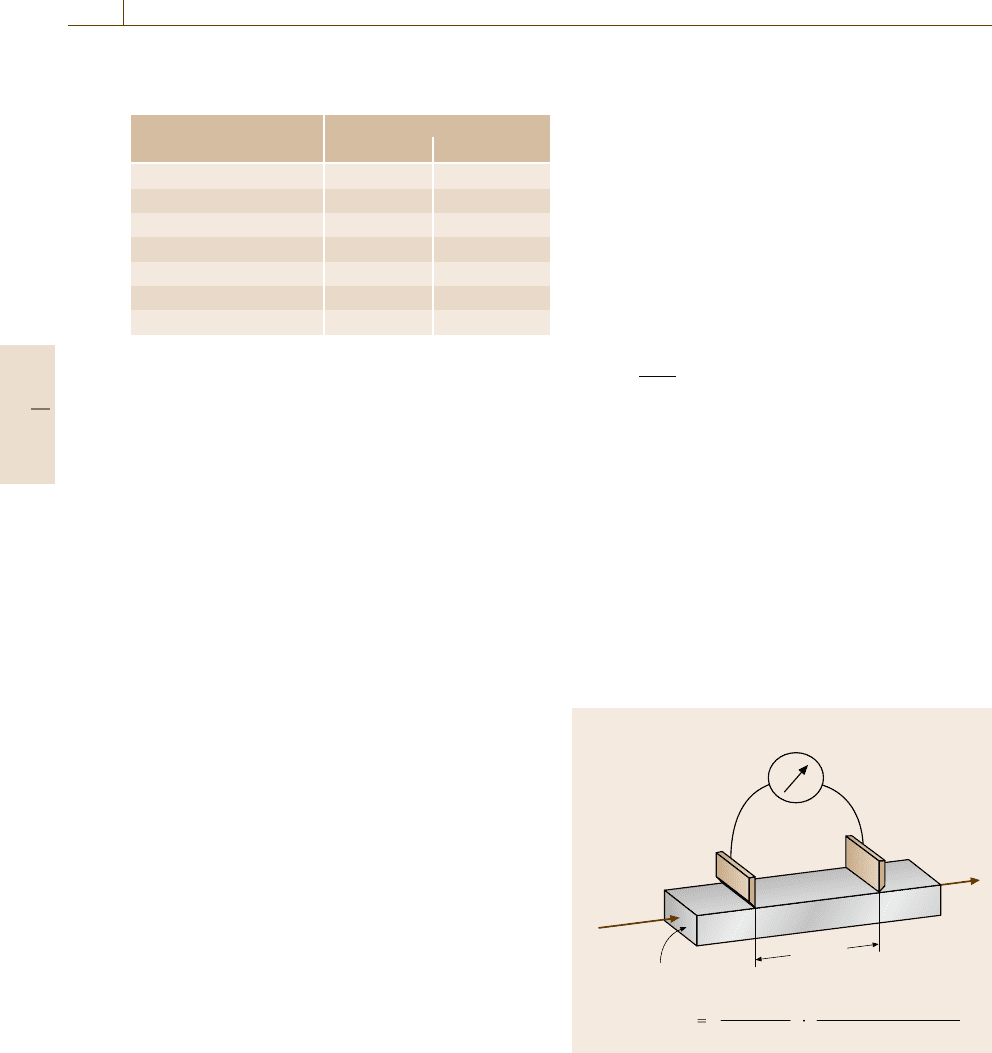
494 Part C Materials Properties Measurement
Table 9.3 Typical values for the conductivity of metals and
alloys
Metal/alloy Conductivity at 20
◦
C
(MS/m) (% IACS)
Copper (soft) 59.9 103.3
Copper (annealed) 58 100.0
Aluminum (soft) 35.7 61.6
E-AlMgSi (Aldrey) 30.0 51.7
Brass (CuZn40) 15.0 25.9
Bronze (CuSn6) 9.1 15.7
Titanium 2.4 4.1
whereas the AC methods make use of the eddy cur-
rent principle. Details are described in Sect. 9.2.2 and
for the calibration of reference standards in Sects. 9.2.3
and 9.2.4.
For precise measurements of conductivity reference
materials are needed. Commonly these reference mater-
ials are pure metals and alloys of known composition.
Due to the size of the material samples, these mater-
ials must have a high homogeneity. Another prerequisite
for precise measurement of reference standards for con-
ductivity is the precise knowledge of the dimensions as
well as the geometry of the material under test. Typi-
cal shapes for a reference material are bars or blocks
and the dimensions range from 30 to 80 mm in width,
200–800 mm in length, and 3–10 mm in thickness for
bars and 80 mm × 80 mm × 10 mm for blocks. Opposite
sides of the blocks and bars have to be parallel and
the surface should have mirror finishing. Furthermore,
an important issue is the temperature. The resistiv-
ity of pure metals strongly depends on temperature.
Typical temperature coefficients are of the order of
1×10
−3
K
−1
.
For AC measurements of the electrical conductivity
based on the eddy current method it is important that the
magnetic susceptibility of the material is less than 1.001.
Magnetic impurities in the metal influence the conduc-
tivity as well as the accuracy of the measurement.
The following section describes the principal meth-
ods for the determination of the electrical conductivity of
metals.
9.2.2 Principal Methods
In principal, the measurement methods for electrical
conductivity can be divided in to two sections, direct
current (DC) and alternating current (AC) measurement
methods. Applications are found in several fields of
material testing as there are air craft industry, coin man-
ufacturing, and pure metal manufacturing (e.g. copper,
aluminum). A more qualitative aspect of conductiv-
ity measurements is the nondestructive material testing.
Cracks and voids in the material lead to a local change
in conductivity which can be detected by conductivity
probes. In contrast to the determination of conductivity,
in this case the metals may also be magnetic.
The determination of conductivity with DC is
made by measuring the resistance R and the di-
mensions of the conductor (length l, width w,and
thickness d,Fig.9.12). From these measurements, the
conductivity σ is calculated (9.1)
σ =
l
Rwd
. (9.1)
The resistance R is usually determined by a voltage–
current method. A current I of known value is fed into
the sample and the voltage U is measured via point or
blade contacts. Since the resistance of metals is typi-
cally very low, even for currents of 10 A the voltage
drop is of the order of some μV up to several mV. This
means high sensitive nanovoltmeters have to be used.
The resistance is then calculated according to Ohm’s
law
R =U/I . (9.2)
This method can only be applied to materials of par-
ticular shape like rods or bars. For more complex
Measurement of electrical conductivity
Voltage
Current
Cross sectional area
Length
Conductivity
Current Length
Voltage
Cross sectional area
Fig. 9.12 Principle of conductivity measurements. The
sample under test is of bar shape with known cross sec-
tional area. A current is passed through the sample in
the direction of its longitudinal axis. The voltage drop is
measured with two contacts, either point or blade type, at
a known distance
Part C 9.2

Electrical Properties 9.2 Electrical Conductivity of Metallic Materials 495
A
A
V
V
1
1
2
2
3
3
4
4
R
A
= V
43
/I
12
R
B
= V
23
/I
14
Fig. 9.13 Principle of the van der Pauw measurement. The
van der Pauw method requires two measurements. First the
current is passed into contacts 1 and 2 and the voltage is
measured at contacts 4 and 3, then the current is passed into
contacts 1 and 4 and the voltage is measured at contacts 2
and 3. These two voltage–current measurements together
with the measurement of the thickness of the device under
test allow for the determination of the conductivity
geometries, like, for instance, the surface of an aero-
plane, other methods have been developed.
A local determination of the DC conductivity can be
obtained by the so-called four-point probe. Four-point
electrodes are pressed on the material and a special se-
quence of voltage–current measurements is made. The
basic principle of this method is the van der Pauw
method (Fig. 9.13)[9.3, 4]. The van der Pauw method
consists of two measurements of resistance, R
A
and R
B
R
A
= V
43
/I
12
, R
B
= V
23
/I
14
. (9.3)
From these two measurements and the knowledge of the
thickness of the sample under test, the conductivity can
be determined by the solution of the following equation
e
−π R
A
/R
S
+ e
−π R
B
/R
S
=1 , (9.4)
where R
S
is the resistance to be determined. If R
A
and
R
B
are similar, (9.3) can be simplified and solved for
the conductivity σ as follows
1
σ
=
πd
ln 2
(R
A
+R
B
)
2
, (9.5)
where d is the thickness of the sample. The precision of
such a van der Pauw measurement depends on the flat-
ness and parallelism of the surfaces of the sample and on
the fact that the contacts are point contacts. An error ε
A
B
CD
Fig. 9.14 Cross-
conductivity standard
(after [9.2]). Similar as
in Fig. 9.13,thecur-
rent is either fed into
pairs of contact A–B and
A–D, and the voltages are
measured at contact pairs
D–C and B–C
caused by nonideal point contacts can be estimated by
ε =2.05λ
4
, (9.6)
where, for a sample with square geometry, λ is the ra-
tio of the width of the contact and the length of one side
of the square. Such small contact areas lead to the prob-
lem of local heating since the current density in these
contacts becomes significantly high. On the other hand
a reduction of the current will lead to loss of sensitiv-
ity. A different approach to this problem is the so-called
cross-conductivity standard. If one considers a perfect
square and transforms this via conform transformation
into a star shaped sample (Fig. 9.14)[9.2]. The conduc-
tivity σ is also calculated by (9.4).
DC measurements require a good contact between
material and electrodes. In practice, the surface of
a metal is covered by a thin oxide layer. For a correct DC
measurement this layer has to be penetrated. This prob-
lem can be overcome by the AC measurement method.
The basic principle of AC measurement methods makes
use of eddy currents. Alternating magnetic fields induce
currents in conducting materials. If the alternating mag-
netic fields are induced by a pair of coils, the second coil
in turn picks up the magnetic field produced by the eddy
current. A probe of such a construction acts as a mutual
inductor. The magnetic field, induced in the second coil
is a function of the magnitude of the eddy current which
in turn depends on the conductivity of the material.
Making conductivity measurements with this meth-
od, the skin effect has to be taken into consideration.
The skin effect limits the penetration of the eddy cur-
rents into the material. The higher the conductivity of
the material the smaller is the penetration depth. The
penetration depth δ is approximately
δ =
2
ωσμ
0
, (9.7)
where ω is the angular frequency (2π f )andμ
0
the
vacuum permittivity.
Part C 9.2
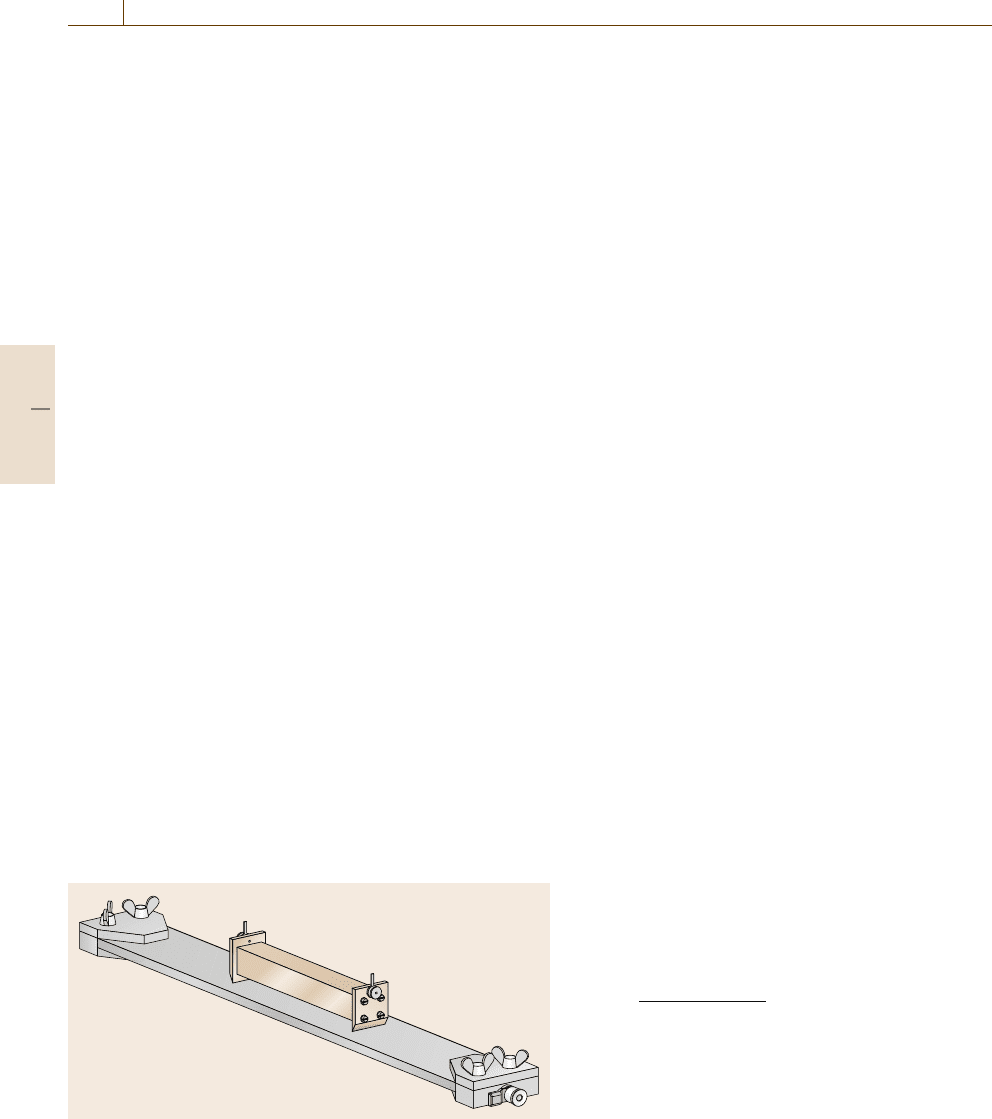
496 Part C Materials Properties Measurement
9.2.3 DC Conductivity, Calibration
of Reference Materials
The DC conductivity is given by a simple model
σ =neμ, (9.8)
where n is the number of electrons, e is the charge of
an electron and μ is its mobility. The number of elec-
trons is nearly the same for all metals, e is constant, but
the mobility depends on the lattice parameters of the
material.
The basic principles and requirements for the mea-
surement of DC conductivity have been laid out in
DIN/IEC 768, Measurement of Metallic Conductiv-
ity [9.5]. The standard to be measured must fulfil certain
criteria regarding its geometry. The length of the sample
hastobeatleast0.3m.ADC current is fed in to the end
sections and the voltage drop is measured with either
sharp point contacts or blade contacts. The distance be-
tween these contacts and the current contacts has to be
at least 1.5 times the circumference (2(t +w)) of the de-
vice under test to allow for uniform current distribution
between the contact electrodes.
The latest practical approach of this method is
showninFig.9.15. The current is fed into the sample
via the clamps at the ends and the potential is measured
at the knife edge blade contacts. The blades are mounted
on a precisely machined stainless steel bar. This method
has the advantage that the distance of the blade con-
tacts has only to be determined once and is the same for
a whole set of measurements. Also the parallelism of
the contacts is assured by this method.
A principal drawback of the DC method is its
sensitivity to oxide layers on certain materials (e.g. alu-
minum). Since a precise knowledge of the thickness of
the sample under test is essential, it is practically im-
Fig. 9.15 Measurement setup for the determination of the DC con-
ductivity of bar-shaped samples. The potential contacts are of knife
edge type
possible to gain full knowledge of the thickness of an
aluminum sample without knowing the thickness of the
oxide layer. A consequence of this problem is the possi-
bility of differences in conductivity values for the same
material determined with the DC method compared to
that determined with the AC method. This problem was
subject of an intensive study [9.6, 7]. Although the rel-
ative uncertainties for conductivity calibrations are of
the order of 0.5% for the AC method and of the or-
derof0.1% for the DC method, differences between
the values could be up to 1%.
9.2.4 AC Conductivity, Calibration
of Reference Materials
In principle, one could think of measuring the AC con-
ductivity in the same way as the DC conductivity. But
the problem of current displacement at AC current is
much more pronounced. Depending on the conductivity
and the measuring frequency, the current flows in a thin
layer at the surface of the material. The thickness of this
layer can be estimated by (9.5). So it is not possible
to exactly determine the AC conductivity by a sim-
ple current–voltage measurement since one dimension,
the thickness, is not known without knowledge of the
conductivity. On the other hand, most commercial con-
ductivity meters measure with an AC method. To meet
the demand of AC conductivity calibration, a suitable
method has been developed at the National Physics Lab-
oratory Teddington, UK (NPL)[9.8].
Alternating electromagnetic fields can penetrate
metallic materials and so generate an eddy current in
the material. This effect is used in a way that the mater-
ial under test is induced into a nearly ideal inductor. Due
to the eddy currents, the inductor is no longer ideal but
shows magnetic loss. This loss can be measured as the
resistive part of the inductor and from that resistance
the conductivity can be calculated according to (9.9).
From two-dimensional theory this resistance R
m
can be
deduced which is not a real resistance but a process of
energy loss modelled by a resistance
σ =
2ω(b +d)
2
μ
0
N
4
R
2
m
l
2
. (9.9)
The measurement system used is the so-called Heyd-
weiller bridge (Fig. 9.16). The bridge consists of the
mutual inductor M with N windings, two fixed resis-
tors R
1
and R
4
, and the balancing circuit R
21
, R
22
, C,
and R
v
. The mutual inductor is of toroidal shape. It can
be opened and a specimen of annular shape of width
b =80 mm, thickness d = 10 mm, and central circum-
Part C 9.2
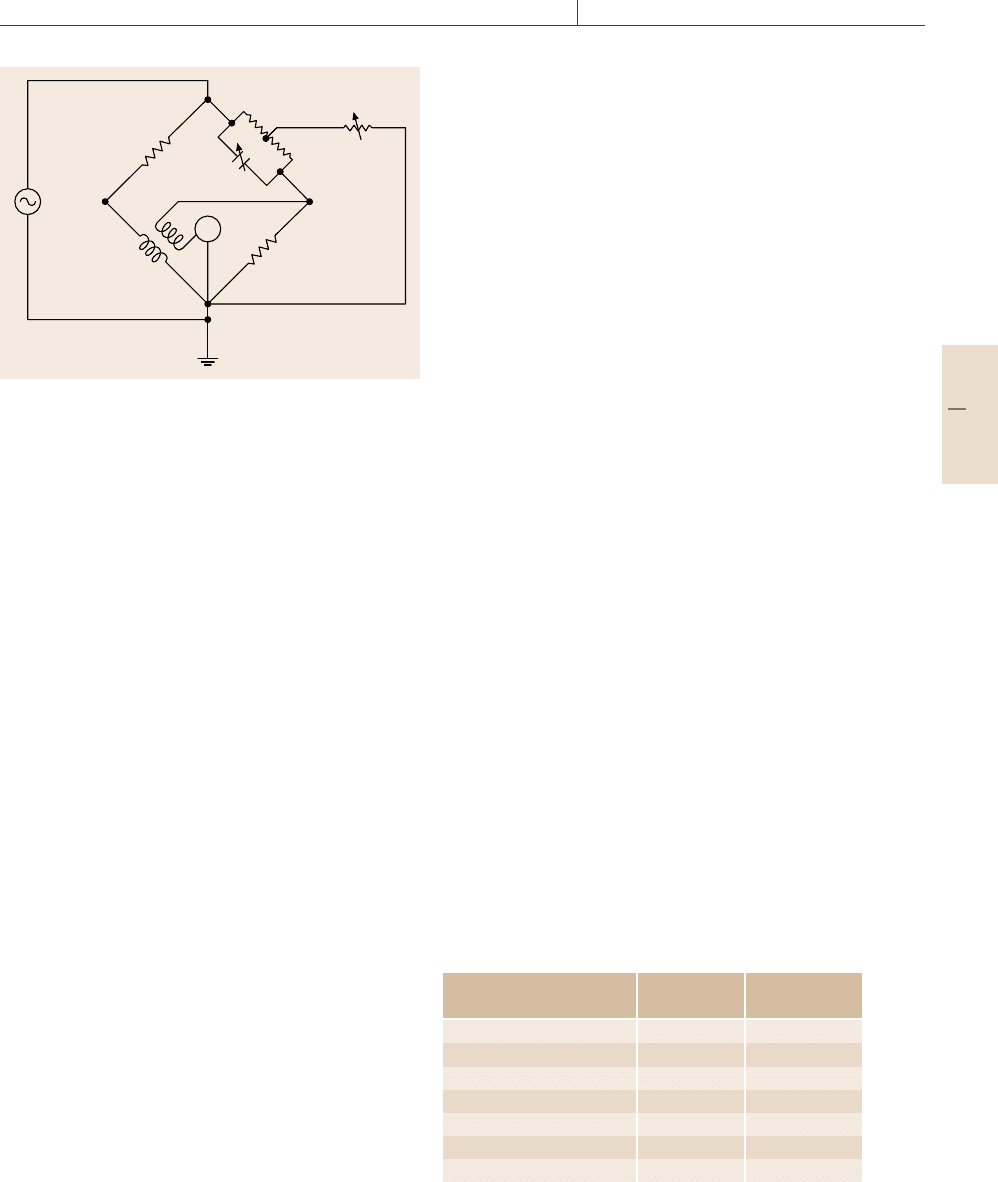
Electrical Properties 9.2 Electrical Conductivity of Metallic Materials 497
R
4
C
R
1
R
21
R
22
R
v
D
M
R
1
Fig. 9.16 Heydweiller bridge for measuring NPL primary
conductivity standards at frequencies from 10 to 100 kHz.
The standard under test is brought into the mutual inductor
M. From the change in R
v
, necessary to balance the bridge,
the conductivity can be calculated (R
v
= variable resistor,
C = variable capacitor, R
21
= R
22
= 10 kΩ, R
1
= 1kΩ,
R
4
=10 Ω, M = inductor)
ference l =320 π mm, can be inserted. From the change
in resistance R
v
necessary to balance the bridge, R
m
is
determined and the conductivity can be calculated.
Since the annulus is of considerable size (0.4m in
diameter), the conductivity value of a selected segment
that represents the average value of conductivity of the
specimen is transferred to a block shaped sample of
size 80 mm × 80 mm × 10 mm. The system used for this
transfer is the same bridge system, the mutual inductor
is a coil of approximately 80 mm in diameter which can
be placed on the annulus as well as on the block. These
blocks then can be used as reference material.
9.2.5 Superconductivity
Some metals, alloys, compounds and ceramic materials
lose their resistance, if they are cooled down to very low
temperatures of some K [9.9]. The physical principle is
that in these materials electrons of opposite spin and of
opposite momentum form pairs. As these pairs have no
spin, they can occupy the same lowest energy state. This
state allows dissipation free transport of electrical en-
ergy since the pairs are not scattered by the surrounding
lattice that means an electrical current is carried with-
out measurable resistivity [9.10]. The transition into this
state occurs at a critical temperature T
c
and varies with
the type of material. For so-called low-temperature su-
perconductors (LTS) the critical temperature is in the
range up to 30 K, for high-temperature superconduc-
tors (HTS) T
c
can be even higher than 100 K. LTS
are typically pure metals or alloys, like e.g. lead (Pb),
niobium (Nb), tin (Sn), or Nb
3
Sn. The HTS are per-
ovskite crystals of mixed copper oxides. This class
of material has been discovered in the mid 1980,
first by Bednorz and Müller [9.11]. From that time
on, various compositions of copper oxides with rare-
earth metals have been investigated [9.12]. The first
reproducible composite was barium-lanthanum-copper-
oxide (BaLaCuO) which showed a critical temperature
of 40 K. For tellurium-barium-calcium-copper-oxide
(TBCCO)aT
c
of as high as 125 K was observed [9.13].
Superconductors of either type are used for several
purposes, as there are
•
the transport of electrical energy,
•
the generation of high magnetic fields,
•
sensitive measurements of small magnetic fields
with superconducting quantum interference devices
(SQUID)[9.14],
•
recently quantum computing, based on QUBITs,
•
arrays of superconducting contacts are used as volt-
age standards.
The first two are DC or low-frequency applications, the
other applications make use of the so-called Joseph-
son effect (at radio/microwave frequencies) which is
described in detail in [9.15,16].
Superconductors need low temperatures so ap-
plications using LTS are typically operated at the
temperature of liquid helium (4.2 K), whereas HTS can
be operated at the temperature of liquid nitrogen (77 K).
The latter is becoming more and more of interest for
industrial applications, since on the one hand it is possi-
ble to produce mechanically stable ceramic components
(e.g. of YBaCuO), and on the other hand the effort for
cooling and thermal isolation is less than that for LTC.
The use of superconductors for the generation of
high magnetic fields requires to pay attention to their
behavior in magnetic fields. This behavior can be di-
Table 9.4 Some typical values for superconductors
Metal/alloy/material T
c
(K) B
c
(T)
at 4.2K
Tin (Sn) 3.7 0.03
Lead (Pb) 7.3 0.08
Niobium (Nb) 9.2 0.2
Nb
3
Sn 19 24
Nb
3
Ge 23 38
YBaCuO 93 55
BSCCO 110 29
Part C 9.2
